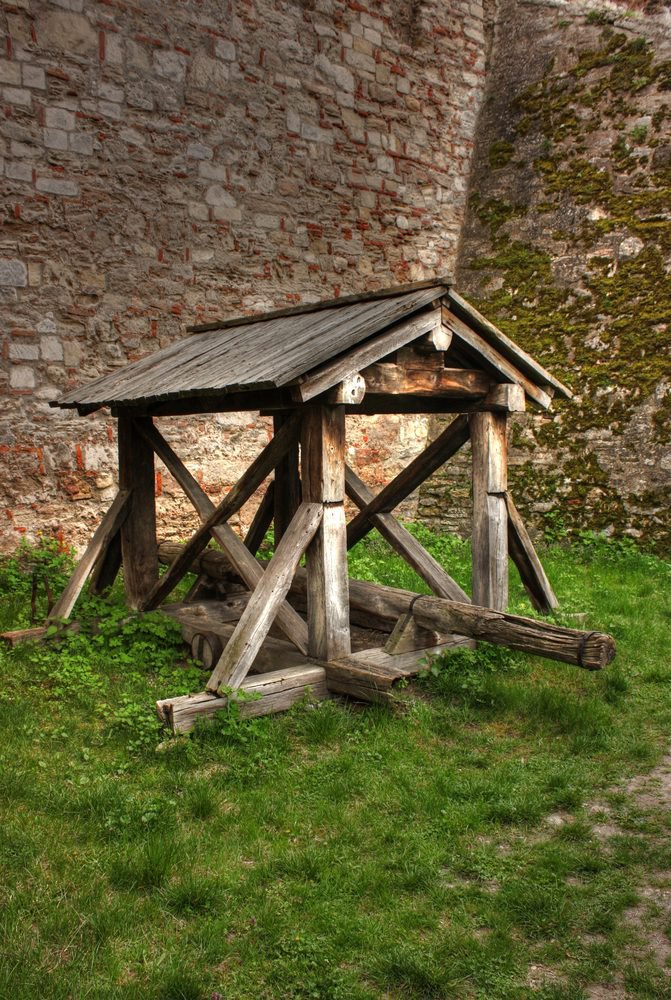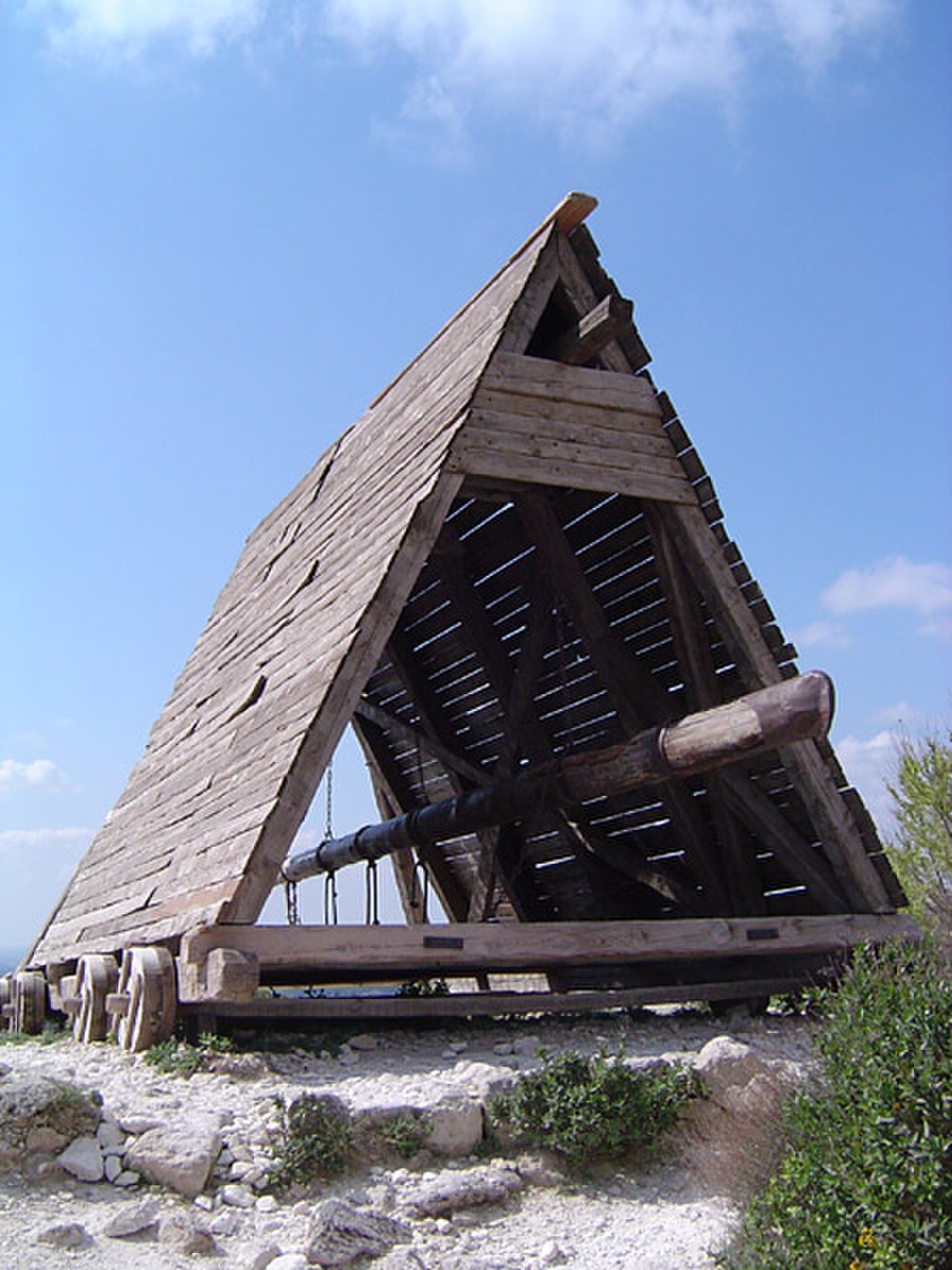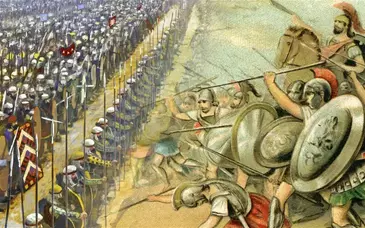Battering Ram: a siege engine designed to break open fortifications
A battering ram is a siege engine originating in ancient times and designed to break open the masonry walls of fortifications or splinter their wooden gates. It was used, too, in ancient Roman mines and quarries to attack hard rocks.
In its simplest form, a battering ram is just a large, heavy log carried by several people and propelled with force against an obstacle; the ram would be sufficient to damage the target if the log were massive enough and/or it were moved quickly enough (that is, if it had enough momentum).
Later rams encased the log in an arrow-proof, fire-resistant canopy mounted on wheels. Inside the canopy, the log was swung from suspensory chains or ropes to maximize its impact power.

Rams proved effective weapons of war because old fashioned wall-building materials such as stone and brick were weak in tension, and therefore prone to cracking when impacted with sufficient force. With repeated blows, the cracks would grow steadily until a hole was created. Eventually, a breach would appear in the fabric of the wall—enabling armed attackers to force their way through the gap and engage the inhabitants of the citadel.
The greater the weight of the ram, the quicker and more serious the damage inflicted on the target wall, although different materials will display varying grades of resistance to the ram's impact. Clearly a wall made from, say, hard granite will offer more resistance compared to one constructed out of soft limestone or mud brick.
The introduction in the later Middle Ages of siege cannons, which harnessed the explosive power of gunpowder to propel weighty stone or iron balls against fortified obstacles, spelled the end of battering rams and other traditional siege weapons. Much smaller, hand-held versions of battering rams are still used today, however, by law enforcement officers and military personnel to bash open locked doors.

During Iron Age, in the ancient Middle East and Mediterranean, the battering ram's log was slung from a wheeled frame by ropes or chains so that it could be made more massive and be more easily bashed against its target. Frequently, the ram's point would be reinforced with a metal head or cap while vulnerable parts of the shaft were bound with strengthening metal bands.
Many battering rams possessed curved or slanted wooden roofs and side-screens covered in protective materials, usually fresh wet hides, presumably skinned from animals eaten by the besiegers. These hide canopies stopped the ram from being set on fire. They also safeguarded the operators of the ram against arrow and spear volleys launched from above.
A well-known image of an Assyrian battering ram depicts how sophisticated attacking and defensive practices had become by the 9th century BC. The defenders of a town wall are trying to set the ram alight with torches and have also put a chain under it. The attackers are trying to pull on the chain to free the ram, while the aforementioned wet hides on the canopy provide protection against the flames.
The first confirmed employment of rams in the Occident happened in 427 BC, when the Spartans besieged Plataea. The first use of rams within the actual Mediterranean Basin, featuring in this case the simultaneous employment of siege towers to shelter the rammers from attack, occurred on the island of Sicily in 409 BC, at the Selinus siege.
Defenders manning castles, forts or bastions would sometimes try to foil battering rams by dropping obstacles in front of the ram, such as a large sack of sawdust, just before the ram's head struck a wall or gate, or by using grappling hooks to immobilize the ram's log. Alternatively, the ram could be set ablaze, doused in fire-heated sand, pounded by boulders dropped from battlements or invested by a rapid sally of troops.
Some battering rams were not slung from ropes or chains, but were instead supported by rollers. This allowed the ram to achieve a greater speed before striking its target, making it more destructive. Such a ram, as used by Alexander the Great, is described by the writer Vitruvius.
Alternatives to the battering ram included the drill, the sapper's mouse, the pick and the siege hook. These devices were smaller than a ram and could be used in confined spaces.

Battering rams had an important effect on the evolution of defensive walls, which were constructed ever more ingeniously in a bid to nullify the effects of siege engines. Historical instances of the usage of battering rams in sieges of major cities include:
- The destruction of Jerusalem by the Romans,
- The Crusades,
- The fall of Rome,
- The siege of Constantinople.
There is a popular myth in Gloucester that the famous children's rhyme, Humpty Dumpty, is about a battering ram used in the siege of Gloucester in 1643, during the English Civil War. However, the story is almost certainly untrue; during the siege, which lasted only one month, no battering rams were used, although many cannons were. The idea seems to have originated in a spoof history essay by Professor David Daube written for The Oxford Magazine in 1956, which was widely believed despite obvious improbabilities (e.g., planning to cross River Severn by running the ram down a hill at speed, although the river is about 30 m (100 feet) wide at this point).
A capped ram is a battering ram that has an accessory at the head (usually made of iron or steel and sometimes punningly shaped into the head and horns of an ovine ram) to do more damage to a building. It was much more effective at destroying enemy walls and buildings than an uncapped ram but was heavier to carry.


